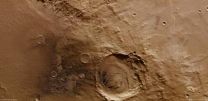Phase III efficacy data on bevacizumab plus chemotherapy in early breast cancer to be presented
2010-12-11
(Press-News.org) SAN ANTONIO — Results of the GeparQuinto study, randomized Phase III efficacy data on the use of bevacizumab plus chemotherapy to treat women with early breast cancer will be presented at the 33rd Annual CTRC-AACR San Antonio Breast Cancer Symposium.
Gunter von Minckwitz, M.D., Ph.D., managing director of the German Breast Group, and colleagues are conducting final analyses on efficacy data from this study, which will detail the early treatment of more than 1,900 patients with HER2-negative breast cancer treated with chemotherapy with or without bevacizumab.
"So far, no efficacy data from Phase III trials have been reported for early breast cancer. This will be the first," said von Minckwitz. "If the pathological complete response rate is higher with bevacizmab than without bevacizumab, it will provide a new option to improve neoadjuvant treatment in HER2-negative breast cancer."
Bevacizumab is currently approved in the United States in combination with paclitaxel for the first-line treatment of metastatic breast cancer. In July 2010, the Food and Drug Administration's Oncologic Drugs Advisory Committee voted 12 to 1 to eliminate this indication from the treatment label of bevacizumab.
"A negative or positive result might have a significant effect on this picture," said von Minckwitz. "However, pathological response as a surrogate for outcome is only confirmed for chemotherapy. Long-term follow up, as well as results from adjuvant studies have to be awaited."
The researchers investigated whether adding bevacizumab to treatment with four cycles of epirubicin/cyclophosphomide, followed by four cycles of docetaxel improved the rate of pathological complete response, which was defined as no invasive or non-invasive residual cancer in the breast or nodes.
Between May 2007 and June 2010, 944 patients were assigned chemotherapy treatment with epirubicin/cyclophosphamide followed by docetaxel; 945 patients were assigned this treatment plus bevacizumab.
After the first four cycles, the researchers performed an interim assessment; 24 percent of patients treated without bevacizumab and 17 percent of patients treated with bevacizumab showed no response and were discontinued from treatment.
Interim safety data from the trial, published earlier this year, indicated that treatment with bevacizumab was feasible. Patients assigned bevacizumab experienced more leukopenia, infections, mucositis and hypertension, but less edema. This safety profile is no different from that reported in first-line metastatic trials or Phase II adjuvant trials of bevacizumab, according to von Minckwitz.
Full results on the histological response and surgical outcome will be reported during the symposium.
"The results will provide an important signal as to whether bevacizumab will be effective as an adjuvant treatment," said von Minckwitz.
###
Follow the AACR on Twitter @AACR, and throughout the meeting using the hash tag #SABCS.
Recordings of the teleconferences and video interviews with researchers will posted to the AACR website throughout the meeting: http://www.aacr.org/page23506.aspx.
The mission of the CTRC-AACR San Antonio Breast Cancer Symposium is to produce a unique and comprehensive scientific meeting that encompasses the full spectrum of breast cancer research, facilitating the rapid translation of new knowledge into better care for breast cancer patients. The Cancer Therapy & Research Center (CTRC) at The University of Texas Health Science Center at San Antonio, the American Association for Cancer Research (AACR) and Baylor College of Medicine are joint sponsors of the San Antonio Breast Cancer Symposium. This collaboration utilizes the clinical strengths of the CTRC and Baylor, and the AACR's scientific prestige in basic, translational and clinical cancer research to expedite the delivery of the latest scientific advances to the clinic. The 33rd annual symposium is expected to draw nearly 9,000 participants from more than 90 countries.
ELSE PRESS RELEASES FROM THIS DATE:
2010-12-11
Bees can see colours but they perceive the world differently to us, including variations in hue that we cannot ourselves distinguish.
Researchers at Queen Mary, University of London and Imperial College London have developed FReD – the Floral Reflectance Database – which holds data on what colours flowers appear to be, to bees. The development of the catalogue, which has involved a collaborative effort between researchers at two Schools at Queen Mary is reported in the journal PLoS ONE.
The work addresses the existing issue that records of flower colours do not take ...
2010-12-11
Up to 20% of professional boxers develop neuropsychiatric sequelae. But which acute complications and which late sequelae can boxers expect throughout the course of their career? These are the questions studied by Hans Förstl from the Technical University Munich and his co-authors in the current issue of Deutsches Ärzteblatt International (Dtsch Arztebl Int 2010; 107[47]: 835-9).
Their evaluation of the biggest studies on the subject of boxers' health in the past 10 years yielded the following results: The most relevant acute consequence is the knock-out, which conforms ...
2010-12-11
The small crater embedded in the northwestern rim of the Schiaparelli impact basin features prominently in this new image from ESA's Mars Express. All around is evidence for past water and the great martian winds that periodically blow.
Schiaparelli is a large impact basin about 460 km in diameter located in the eastern Terra Meridiani region of the equator of Mars. The centre of the basin lies at about 3°S/17°E and is named after the Italian astronomer Giovanni Schiaparelli (1835�). Although he also studied Mercury and Venus, he is best known for his observations ...
2010-12-11
Despite threats of violence, imprisonment and death, writers around the world continue to fight to make their voices heard. The latest issue of Index on Censorship pays tribute to one of the world's longest running campaigns for free expression, English PEN's Writers in Prison Committee (WiPC). Founded in 1960, the WiPC supports and protects writers facing persecution around the globe. Contributors to Beyond Bars – including award-winning authors Margaret Atwood, Sir Tom Stoppard and William Boyd – highlight the vital role writers can play in supporting their colleagues. ...
2010-12-11
As the U.S. policy makers renew emphasis on the use of nuclear energy in their efforts to reduce the country's oil dependence, other factors come into play. One concern of paramount importance is the seismic hazard at the site where nuclear reactors are located.
Russell A. Green, associate professor of civil and environmental engineering at Virginia Tech, spent five years as an earthquake engineer for the U.S. Defense Nuclear Facilities Safety Board in Washington, D.C., prior to becoming a university professor. Part of his responsibility at the safety board was to perform ...
2010-12-11
Iron furnaces that once dotted central Pennsylvania may have left a legacy of manganese enriched soils, according to Penn State geoscientists. This manganese can be toxic to trees, especially sugar maples, and other vegetation.
The research, which quantified the amounts of manganese in soil core samples, was part of work done at the Shale Hills Critical Zone Observatory funded by the National Science Foundation.
"Our group's focus was to study the soil chemistry," said Elizabeth M. Herndon, graduate student in geosciences. "We saw excess manganese in the soil and ...
2010-12-11
Children with ADHD can sometimes have more difficulties on math and reading tests compared to their peers. A new study published in Psychological Science, a journal of the Association for Psychological Science, used identical and fraternal twins to look at the genetic and environmental influences underlying ADHD behaviors, reading, and math skills in children in an attempt to better understand the relationship among them.
Sara Hart, of the Florida State University, and her colleagues used twins enrolled in a long-term study of reading and math. Hart says by focusing ...
2010-12-11
Alexandria, VA – America has made great strides in recent years to reduce carbon emissions by increasing efficiency and turning to other, low or non-carbon energy sources. Meanwhile, carbon emissions in China have grown dramatically during that same time. EARTH looks at this disparity and asks the difficult questions about who is to blame when the coal China is burning is imported from "cleaner" countries and the emissions are produced to manufacture goods exported back to places with lower emissions.
Learn more about this eye-opening subject in January's featured article ...
2010-12-11
ORLANDO - A two-drug combination is safe and active in newly diagnosed acute myeloid leukemia and myelodysplastic syndrome patients who are usually excluded from clinical trials because they have other illnesses or poor performance status - a measure of disease progression - researchers reported this week at the 52nd American Society of Hematology Annual Meeting.
"Our findings suggest current eligibility standards that prevent participation by these patients in phase I and phase II clinical trials might be inadequate," said Guillermo Garcia-Manero, M.D., professor in ...
2010-12-11
Scientists have discovered how a network of repair proteins enables bacteria to prioritise the repair of the most heavily used regions of the DNA molecules that carry the instructions necessary for living cells to function.
The research, carried out by academics at the University of Bristol and published in Molecular Cell (Dec. 2010), reveals that there are greater similarities between the DNA repair systems of bacteria and humans than had been suspected.
When the chemical "letters" in a cell's DNA book of instructions are damaged the instructions become difficult ...
LAST 30 PRESS RELEASES:
[Press-News.org] Phase III efficacy data on bevacizumab plus chemotherapy in early breast cancer to be presented




